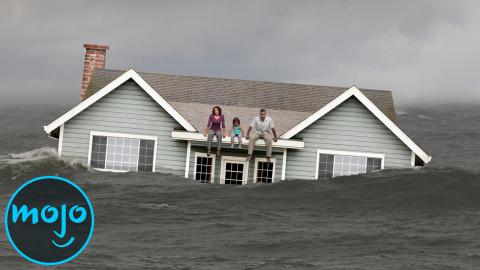Top 5 Facts About Flooding

Water might be essential to life, but this is clearly too much of a good thing. From the aftereffects to the immeasurable damage, here are some things you need to know about flooding. WatchMojo counts down the Top 5 Facts About Flooding.
Special thanks to our user Kris A for suggesting this idea! Check out the voting page at http://WatchMojo.comsuggest/Top+5+Facts+About+Flooding.
#5: They Can Come Out of Nowhere
Flooding is always serious business, but at least when it’s a slow buildup you have time to prepare or evacuate. When flash flooding occurs, low-lying, but fast moving water rushes through an area with little warning, picking up debris as it goes. They typically result from heavy rainfall in a flat area where there is poor drainage or soil with limited water retention. Because of the relatively low height of flash flood water, people tend not to take it seriously, but it has the ability to sweep away pedestrians and vehicles alike, with potentially fatal results. They’re particularly dangerous in canyons and ravines.
#4: They Come in Various Forms, Each with Their Own Unique Risks
Coastal flooding happens along the ocean, and is characterized by heavy surges of water pushing up well beyond the beachfront. During heavy storms, water can hit coastal property or roadways with colossal force. Depending on the geography and conditions, it doesn’t always run off. Then, there’s over-bank flooding, which is something riverside communities are all too familiar with. Though it may rise slowly, the river water, when it rises above the embankments, can cover large areas of land, incapacitating entire neighborhoods. In regions where winter is harsh, large pieces of surface ice can form natural dams, which results in frigid water being diverted onto land in what’s known as “ice jam flooding”.
#3: You Don't Know What's in the Water
When it comes to flooding, one of the biggest risks is something most people never even consider - the contents of the water. Even if you know the source, you have no idea what it has picked up along the way. If you’re in an agricultural area, consider all the manure and fertilizer. In the suburbs, the sewage and drainage systems will be backed up, meaning that a whole lot of waste could be on the move. Then there’s all the physical debris and garbage to take into account. Regardless of how shallow or slow moving the water might be - avoid making contact, and if that’s not possible, make sure to clean yourself off, ASAP.
#2: They Are Very Costly
How much damage could a little water do? Apparently... quite a lot. The average claim per household after a flood is $39,000, which, might not sound like a lot compared to the price of a home. But when you multiply that by the number of homes and businesses affected by flooding every year… those numbers start to add up. Even relatively modest floods can cost millions of dollars, while the major ones in American history have cost in the billions. In 1993, when the Mississippi River Basin flooded in what has since been dubbed the “Great Flood,” the damages totaled as much as an estimated $20 billion. In 2017, flooding came out as the most costly natural disaster in America.
#1: You're Left with Big Problems After the Water Recedes
When the offending water finally recedes, there’s naturally a feeling of relief, but celebration is short-lived. As the water dissipates, it reveals the full extent of the damage done... and it’s usually ugly. Dirt, grime and sediment coats pretty much everything below the flood-line, along with debris and garbage. Buildings need to be evaluated for structural integrity, and even if they prove solid, mold becomes a serious concern moving forward. In agricultural areas, risk of soil contamination is high, and proper testing needs to be done before work can resume. Regardless of where you live, after a flood hits, it takes a lot of time and effort to return life to normal.